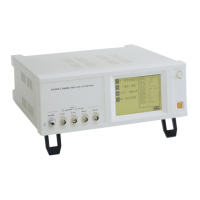44
────────────────────────────────────────────────────
4.4 Setting the Test Signal Level
────────────────────────────────────────────────────
4.4.5 Setting the Constant Current (CC) Level
Test signal level
setting screen
The digit keys (If held down continuously, the corresponding digit increments
or decrements continuously.) (If the limit for the corresponding digit is reached,
these keys change to non-reversed video and become inactive.)
Monitor display
・
Test frequency
・
Set value for constant
current
・
Current flowing
through the test
sample
・
Limit value for the
voltage
・
Voltage between test
samples
NOTE
1. Press this key to set constant current (CC), and the monitor display will
change immediately.
2. Change the set constant current value using the digit keys.
3. When the setting has been established, press the key to return to the
Initial screen.
Testing some types of sample is not possible using constant current. In this
case, the following symbol appears on the display:
In such a case, constant current testing is not performed. Change the
constant current level to a value not more than the value being shown as
Imoni.
Reference
When a 10 mH impedance is measured at 1 kHz, the CC operation range
can be obtained as follows. Sample impedance Zm becomes as follows:
Zm = Rm + jXm = 0Ω + j62.8Ω Xm: 2πfL
The impedance Zm' observed from the generator is as follows:
Zm'=Ro+Zm=50Ω + j62.8Ω Ro: output resistance (50 Ω)
Accordingly, the voltage Im across both leads of the sample is as follows:
Im = Vo/|Zm'| = Vo/80.3Ω Vo: generator output
Because the generator output voltage range is 10 mV to 5 V for 1 kHz, the
CC operation range per the above expression is Im = 125 μA to 62.3 mA.

